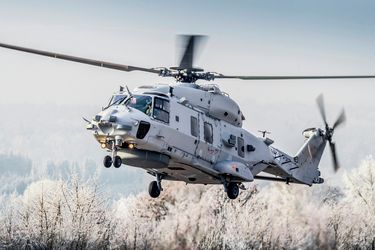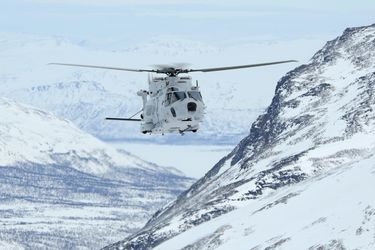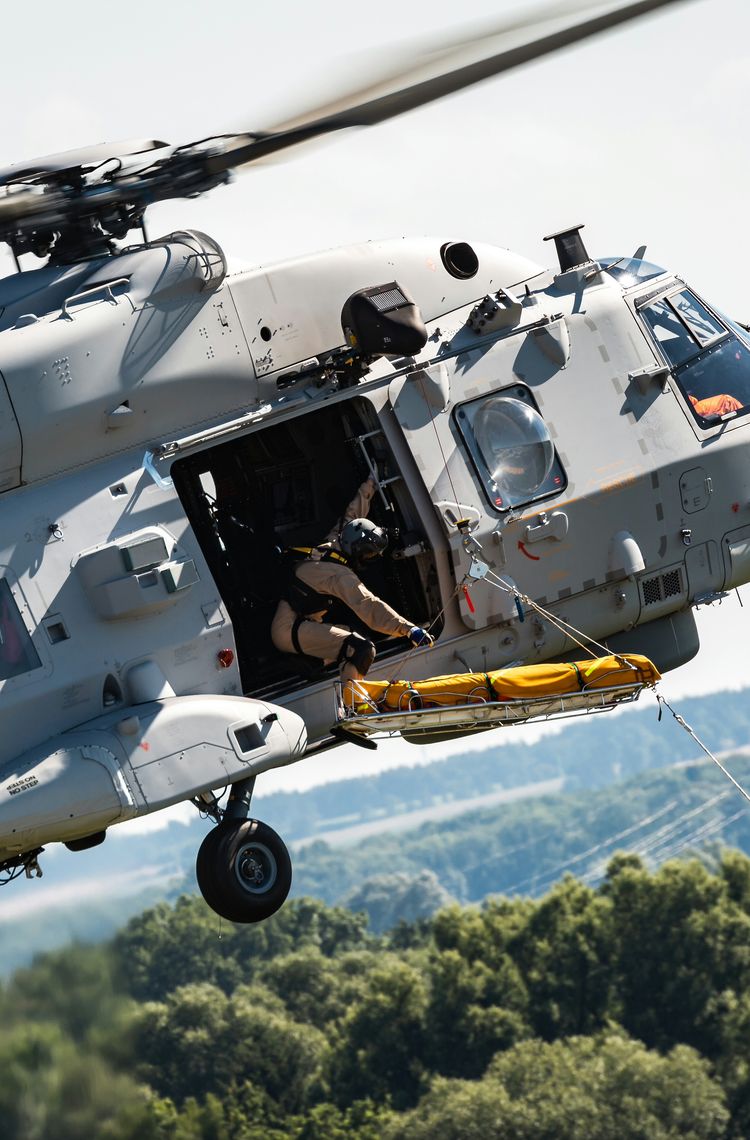Article: Frédéric Lert
Media: Airbus Helicopters, NHIndustries, Christian D. Keller, Finnish Defence Forces, Patrick Heinz, Anthony Pecchi
Today, more than 560 NH90s have been sold in fourteen countries, emphasises Matthieu Louvot, Executive Vice-President of Airbus Helicopters Programmes. "The last few years have seen Germany opt for the Sea Lion to replace its Sea King and the German Ministry of Defence has already communicated its wish to replace its Sea Lynx with more than thirty NH90s. 2015 saw France order six additional rotorcraft, followed in 2018 by Qatar and this year by Spain." You don't become a market leader by chance. When the NH90 programme was launched in 1992, the specifications sent to the three partners of the NHIndustries consortium (Eurocopter, AgustaWestland and Fokker) set the bar very high for technical innovations, in particular for developing fly-by-wire (FBW). A first on a series-manufactured helicopter.
NH90: High Level of Flight Quality
"We had to develop an aircraft that had the best flying qualities on the market, and that would meet the needs of all the military missions that could be entrusted to a 10-ton class helicopter on land and sea," recalls Jacques Bellera, Head of Airbus Helicopters’ Fly-By-Wire Department. "To illustrate the extremely high contractual requirement, we had for example, to demonstrate compliance with the highest level of standard ADS33 which is the most comprehensive and most demanding US Army standard regarding the demonstration of flight qualities. To meet all the constraints imposed on the flight control system, we used the fly-by-wire controls in order to provide very high performance piloting assistance while guaranteeing maximum safety due to an optimised system architecture. Despite the very strong constraints, a severely vibrational environment, a limited space and the requirement of redundancy and dissimilarity of the control chains, we achieved our goal. NH90 therefore became the first aircraft in the world to demonstrate Level 1 of standard ADS33 during qualification. This high level of flight quality achieved using fly-by-wire is much appreciated by its pilots throughout its field of use and on all theatres of operation. Beneficial effects have been felt in many areas."

We had to develop an aircraft that had the best flying qualities on the market, and that would meet the needs of all the military missions that could be entrusted to a 10-ton class helicopter on land and sea.
- Jacques Bellera, Head of Airbus Helicopters’ Fly By Wire Department
On a helicopter equipped with mechanical flight controls, the diamond shape of the fuselage (to reduce the radar detection) as well as the aircraft design (to maximise the interior volume) would have had an impact on the aircraft’s flight characteristics. This is not the case on the NH90. Likewise, reducing the size of the tailplane made it possible to lighten the aircraft and limit impact on attitude during approaches for ship landing. The impact of this smaller tailplane at high speed was fully compensated by the FBW controls which led to optimisation over the entire operational domain, delivering outstanding deck landing performance in the extremely demanding environment of a boat deck subject to high winds and movements.
"Fly-by-wire means that the piloting limits can be approached risk-free, while retaining the margin in power and flyability," summarises Didier Delsalle, Airbus NH90 Project experimental test pilot. "Freed from flying tasks, the pilot can focus on the mission. The NH90 is also a very fast aircraft with an excellent rotor, which remains very controllable throughout its flight envelope. For all the pilots who have tried it, the NH90 combines the power of the Tiger with the agility of the Ecureuil." A comparison that is much more than an allusion; all the pilots who have used the aircraft in operation can testify to its level of performance. Italian and German rotorcraft in Afghanistan, French ones in the Sahel etc.; at all latitudes and at all altitudes, the NH90 simplifies flying and takes care of its crew. "Less tired pilots means safer pilots," points out Didier Delsalle.
Another example of the value of the aircraft's flight controls is provided by Jacques Bellera: "The NH90 comes in two cabin heights, the largest developed at the request of the Swedish customer. The stability provided by the FBW controls we have developed is such that pilots can experience the same flying qualities and feel from one helicopter to another. The same goes for all the optional equipment that can be installed on the aircraft in a wide range of missions: torpedoes, missiles, additional tanks etc., since the fly-by-wire absorbs all the alterations in the flight qualities of the aircraft without the pilots experiencing any difference in feel, whatever the environmental conditions (night, downgraded visual conditions, IFR, etc.)."
Fly-by-wire means that the piloting limits can be approached risk-free, while retaining the margin in power and flyability. Freed from flying tasks, the pilot can focus on the mission.
- Didier Delsalle, Airbus NH90 Project experimental test pilot

Standard 2 Project
One of the strengths of the NH90 is that it is continuously updated further to requests made by its 14 customers, for the benefit of the entire community.
Among them, Standard 2, the major update of the NH90 currently under development, responds to this logic. The first requirements relating to this new standard were expressed in 2014 by the French Special Forces. Placed under a bushel for budgetary reasons, Standard 2 resurfaced in 2017 as part of a cooperation with Australia, which was later joined by Belgium."
"The signing of a development contract between these three countries is now expected for early 2020," explains Jean-François Ménière, Head of NH90 Programme Management France and Standard 2 Project. "France currently has 74 NH90s on order and the last ten are planned to be delivered directly in Standard 2. The Australian and Belgian aircraft, respectively forty-seven and four already delivered, will benefit from a retrofit." The scope of Standard 2 focuses on the digitisation of the NH90 sensors, i.e., the integration of the Safran EuroFlir™ MSP410D mission ball and its ten integrated multiband sensors, the replacement of the FLIR with fixed distributed sensors, the image merger of which offers a 220° panoramic view. "These sensors provide a TV and infrared video stream to the two pilots and to tablets that can be used by passengers in the hold,” specifies Jean-François Menière. "Flight safety will be greatly improved, with a better understanding of the environment in degraded environments. Another advantage is that all the video streams can be recorded and used for debriefing or intelligence purposes." The scope of Standard 2 also provides for rear section modifications for greater flexibility for the Special Forces. Note that a request for proposal has also been sent to NHIndustries for improvements on the NFH; a major update of this embedded version is also under study. Evidently, the NH90, created at the end of the 20th century, has all the assets to successfully face the 21st century.
Flight safety will be greatly improved, with a better understanding of the environment in degraded environments.
- Jean-François Ménière, Head of NH90 Programme Management France and Standard 2 Project
NH90 In Action Saving Lives Protecting Heroes
NH90 In Action Saving Lives Protecting Heroes
NHindustries video demonstrating NH09's multi-mission capabilities.





